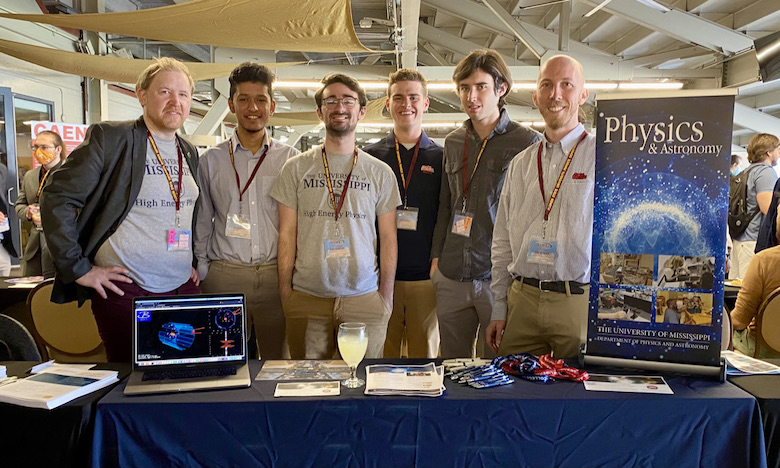
The University of Mississippi table at the 88th conference of the American Physical Society Southeastern Section at Florida State University in Tallahassee in November 2021 are pictured from left to right: Gavin Davies, assistant professor working on experimental particle physics with the NOvA experiment; Sakul Mahat; Paul Gebeline; Wil Stacy; Matthew Mestayer; and Jake Bennett, assistant professor working on experimental particle physics with the Belle II experiment.
Matthew Mestayer, a physics major from Ocean Springs, Mississippi, in his junior year at the University of Mississippi,
He is working with Jake Bennett, an experimental elementary particle physicist and assistant professor in the Department of Physics and Astronomy, and presented his research findings as part of the Belle II experiment at the annual meeting of the Southeastern Section of the American Physical Society at Florida State University in Tallahassee in November 2021.
The Belle II experiment at the SuperKEKB accelerator in Japan—a collaboration with more than 1,000 physicists and engineers from 26 countries—aims to investigate great mysteries of particle physics, including why, if matter and antimatter should have been created in equal amounts after the big bang, is the universe today filled almost entirely with matter?
Mestayer studies the asymmetry produced when a particle is measured with a different efficiency than its antimatter partner. This asymmetry must be well understood because it can hide behavior that violates the laws of physics and, therefore, indicate the presence of new particles and interactions.
“I am studying a particle that clearly obeys the Standard Model in order to understand the detector well enough that we can search for particles that do not,” he said.
How did your interest in physics develop?
My interest in physics started in middle school. I became interested in STEM-related YouTube channels, such as Vsauce, Veritasium, Kurzgesagt, and many others. I credit these channels with sparking my initial curiosity in the natural sciences. My interest for physics began in high school when I took AP physics. Learning actual physics truly invigorated me and gave me an interest in the field. When the time came to pick my major, it was the main thing I was interested in. So, I threw caution to the wind and majored in physics. Looking back on that choice three years later, I do not regret my choice.
Talk about your college experience as a physics major and work participating in research.
Now, I was fairly confident I wanted to major in physics. But I also had an interest in global relations at the time. So I dual majored in the most unlikely combination of subjects. This would not remain the case, as I would eventually choose to pursue physics over international relations. However, my experience with research has been steadily improving. During freshman year, I was still confused on what I was going to do, so I did no research that year. Sophomore year marked my first year doing basic research, where I spent the first half learning the programming language used in my experiment, Python. Then during the second half of sophomore year, I started measuring the detection discrepancy of a certain particle in the Belle II detection system, which started the research I would eventually present at SESAPS. Once I had confirmed that, I then spent the first half of my junior year looking for cp asymmetry, which I had suspected was the cause behind that asymmetry. After some experimentation, I gathered the results I would present at SESAPS.
Discuss your career goals.
I’m not entirely sure what I want to do with my career after school. The only thing I know for certain is that I plan on going to grad school, either in high energy physics or gravitational physics, a field I would like to do some research in come next semester. I plan on obtaining a PhD, then I will either go for the tenure track, or I might go into data science, which I intend to prepare myself for by learning multiple coding languages during grad school. Of course, none of this is set in stone, but that is my general plan for my future.